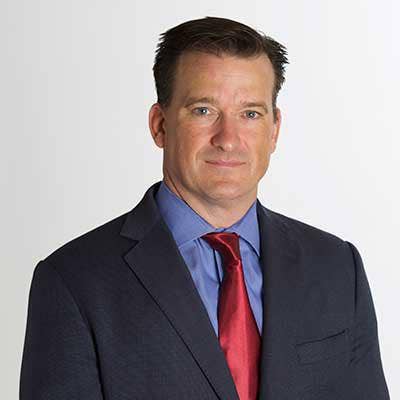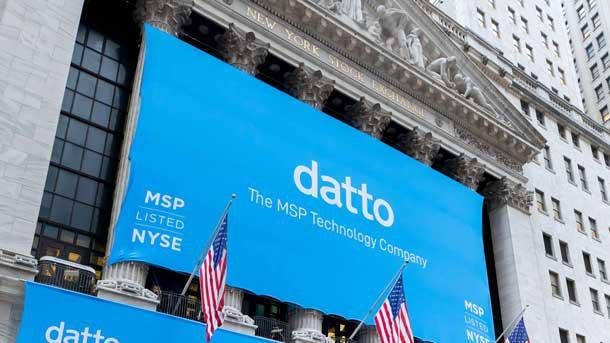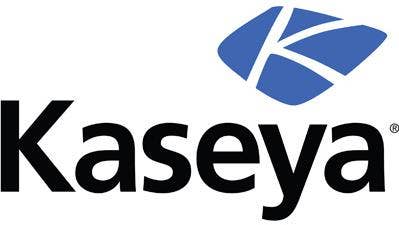Kaseya CEO Fred Voccola On His Rivals, Private Equity And A Possible IPO
The outspoken leader of the ITSM tool provider chimed in on where he sees growth coming from in 2021.

Kaseya Looks To The Future
The loquacious CEO Fred Voccola is coming off a stellar year for Kaseya with growth greater than 20 percent for the IT software vendor. He is looking forward to an even stronger 2021, as IT project work rebounds and the SMB dives deeper into its own digital transformation.
“We’re very fortunate that we’re in this space,” he told CRN. “I think that trend is going to accelerate even further. I think that you’re going to see the -- it’s a cheesy term -- but the digital transformation of literally every SMB industry is going to continue to accelerate massively because the value that can be achieved is so great.”
Voccola said as small businesses return to full operation this year, their remote services – such as telemedicine – will not be turned off, but will continue to generate revenue. Meanwhile overshadowing all of the players in the ITSM space are the billions in private equity and public investment dollars that are flooding the Software-as-a-Service ecosystem.
Kaseya and rival SolarWinds MSP are mulling possible public offerings, while competitor Datto led the way last October with its own public market debut. Voccola said odds are Kaseya will be a publicly traded company by the end of the year.
“I’ll give you a number and I’ll give you some context. There is a 66 percent, two thirds chance we are a public company in calendar 2021,” he said. “There is a 75 percent chance that we are a public company by the end of Q1. The reason there is a delta there, it depends on how quickly we can get all that back office stuff ready to go.”
Two weeks ago, Kaseya acquired RocketCyber, a cybersecurity company that developed a cloud-agent SOC that needs no hardware or specialized equipment, and integrates into a customer’s existing security and ticketing products. It will be added to Kaseya’s IT Complete platform and targeted at SMBs who need 24/7 security monitoring, Voccola said.
“With this acquisition, we’ve doubled down on our security investments to provide our customers with access to experts who can continuously monitor their IT environments without the cost and complexity of disparate tools,” Voccola said.

Could we start off talking about the movement here in this industry? You have Datto going public, SolarWinds potentially spinning out, you guys are talking about going public. There have been some big shifts since the last time we spoke.
It’s interesting. I think it validates a couple of things. One of them is that the underlying trend behind all of this is the digital transformation of small to midsize businesses around the world. We saw this in the enterprise. Most of us that are in software and technology business to business software and technology, it all started in the enterprise. When you think about the ’90s and the 2000s, that’s when companies like Microsoft -- which is a big enterprise-facing company -- Cisco, EMC, Oracle, this is when these companies, made their bones.
The reason why they grew so fast and all the investment happened was because big companies like Lockheed and Gillette, and, Citibank, they all started embracing and using technology as the core of all of their businesses. To the point now where Jamie Dimon, the CEO of JPMorgan Chase, in a very famous interview a couple years ago we quote it all the time, said – and I might have the figure wrong -- “We spend $8 billion a year in technology. We are a technology company.”
Now, if you go back, 10 to 15, years ago, JPMorgan could do that because they have armies of people to implement the stuff. But the little bank you know the Bank of Newton, Mass. or Framingham, Mass., couldn’t do it right. Why? Because there’s two IT people there. But technology’s gotten to the point, it’s a lot faster, it’s a lot more consumable.
So now, the benefits that the giant companies got, small to midsize businesses can get the same things. So they’re rushing to get it. And the way that small to mid sized businesses get their technology for the most part is through MSPs. That’s why you’re seeing companies like Kaseya, Datto, ConnectWise, SolarWinds, all of us are just we’re growing so fast, and we’re having the results that we’re having.

Is that why you are seeing the big private equity players come in, and seeing some of these companies, like Kaseya, look to a private offering?
There’s hundreds of billions of dollars -- that’s not an exaggeration -- that has been raised by private equity firms to invest in software and internet technology facing companies. That provides the capital to do almost anything. You can do just about anything.
Where the public markets come into play, the public markets provide the opportunity for companies to have a currency that they can use for employee incentives. Right now, employees of Kaseya have stock in Kaseya. In order for that stock to become cash, there needs to be some sort of liquidity event. That’s why you are seeing the public markets. Fifteen years ago, before private equity was as funded as it is, companies would go public for access to capital to do things. The access to capital is there now. You don’t need the public to do that. It’s really providing a liquid currency as compensation for employees, that’s one of the reasons you are seeing such a push to go public.

Of the major ITSM providers to MSPs, Datto is the only one that has gone public. SolarWinds has their public side but the MSP tool side is still not public. With Datto only 25 percent of that is publicly available for trade, and if you dig down into the S-1, you can see that unless its PE owner Vista falls below 20-percent ownership it will still control everything, that seems very leveraged towards private equity, no?
There’s a couple of moving parts there. One is it’s not uncommon to have 10, 15, 20% of a company float. Google does the same thing, way, way back in the day, when Google went public. That’s not uncommon. It’s not just a technology thing it. So just to put it in perspective. It also gives Vista, the ability to get liquidity for their asset.
When a company goes public, it is not an exit. Vista will be, and this is this is a good thing not a bad thing by the way, Vista will have a stake in Datto for years. They don’t sell it out .
When we go public, Insight isn’t going to, nor do they want to just sell the shares right away. It’s another vehicle for them. They’ll sell it down over a years and years, for obvious reasons. So, that’s the kind of plan.

Over the last couple years we have seen private equity move in to the ITSM tool space in a big way. The argument is always that having those investments and those players around was a good thing for the industry, but we’ve seen some stumbles by private equity here in the last year or two. You’ve been PE-owned for a while now, what is it that we don’t see?
I’ll tell you why I think ConnectWise is having the struggles that they’re having with private equity. When Kaseya got bought by Insight seven and a half years ago, they had problems at the beginning because ConnectWise, like Kaseya, it was a founder led company. Arnie Bellini and I used to have joking, little spats in the media. We would take digs at each other. But to call it what it is, the dude built a great big company. For better or worse. Whether you liked him or you didn’t, he built a billion-dollar business and he was the face of it. Then he stepped away, and it happened really quickly. I’m not saying Jason is a bad guy. I go back 22 years with Jason. He and my younger brother worked together in New York City when they were just starting their careers. I’m not saying Jason’s bad, but he’s not Arnie, and that is not better or worse.
When Insight bought Kaseya, Gerald Blackie who was the founder and CEO left the next day. The CEO that Insight brought in wasn’t bad, he just wasn’t Gerald. Sometimes private equity firms, might not understand the cultural impact of doing it. When Vista bought Datto, it didn’t go real well because Austin left. It’s not a bad thing, it just is what it is. So I think that’s expected. After a couple years, it resets.
When Kaseya was bought by Insight, it was a crappy two years. We have said it publicly. We screwed up. Hopefully we have righted ourselves. And we screwed up bad. You see some of that happening with ConnectWise now. I’m not trying to poop on them, that’s what it is. It’s hard. If the CEO is not used to how private equity firms operate, it is a big change. Where to push back, where not to push back, all that is different. It takes one to two years to adjust.
Thoma gets very good returns because they are very good at financial engineering, whereas with Insight and Vista, they’re more known for getting returns through growth. The other thing that is tough is that Thoma put them together with Continuum and Michael George is gone. Michael is awesome. He is smart, capable. He is a good dude. And he’s gone and they have to figure that out.

We talked at the beginning of last year and you talked about focusing on SMB growth, capturing mid-sized customers, IT Complete, Kaseya power services, and there were big plans for all of those elements, and then the pandemic hit, but it seems like a lot of your predictions held, and you had a lot of growth in 2020.
We had a really good year. I hate saying that because so many people didn’t have good years. If you are in the restaurant business, or cruise lines, or airlines, retail, it’s been tough.
What happened with COVID, is it’s forcing a trend which is this SMB transformation that we spoke about. It’s accelerating it. Because, the simplest example is if you’re an eye doctor, and you’re told, ’You have to shut your office. You can only take emergencies.’ All right, well, what percentage of an eye doctor’s patients are emergencies? Maybe 1 percent, right. So, your business has to shut down. I have eight employees, what am I going to do? I’m going to furlough them, or I’m going to fire them. I can’t keep paying people. There’s nothing coming in the door. What doctors did is they said, ’OK we’re going to make a shift to telemedicine.’ And I’m simplifying things. So they shift to telemedicine. And while their businesses are only doing 50 to 60 percent of what they did before, that telemedicine is allowing them to do 60 percent instead of 6 percent.
But what do you need to do to implement telemedicine? You need technology. You need HIPPA compliance, you need network management, security software, so their MSP is now getting a larger portion of their revenue than before. That was coming already but it was very gradual. COVID kicked in the ass and made it happen right away.
Now the doctor’s office, once they have gone back to seeing patients, they still do telemedicine, and now, their business is even better because they have the regular patient flow, and they’re augmenting it with telemedicine.
So it worked really well. So what we saw was the economy got walloped second quarter GDP was down like 33 percent or something. Third quarter popped up 33 percent. Overall I think we’ll see when the dust settles GDP, probably shrank about 3 percent, 4 percent this year.
We grew about 21 percent or 22 percent depending how you measure it. I’ve seen lots of data, I don’t know how reliable all of it is, but that the IT and security sector for small to midsize businesses grew about 8 percent. So overall economy down five, and our sector overall up eight. That’s crazy.
I think, you know, we’re just lucky. We’re very fortunate that we’re in this space, but I think that trend is going to accelerate even further. I think that you’re going to see the, it’s a cheesy term, but the digital transformation of literally every SMB industry is going to continue to accelerate massively because the value that can be achieved is so great.
If you’re a doctor’s office, what are you going to do. Are you going to hire another nurse practitioner so you can see more patients, or are you going to set up 15 more telemedicine appointments, so you can generate the same revenue faster?

Where is Kaseya seeing that bump? Are there particular tools? Are there particular areas you are seeing a spike in?
Across the board. Now take this with a grain of salt because we are starting from a small base, so it’s not nearly as big as our backup business, or our RMM business, but one area, our compliance business, grew over 1,000 percent. I’ve seen few things like it. This isn’t a political statement, but governments around the world are regulating more. I don’t know if that’s good or bad, but it’s happening. So if it’s happening, don’t fight it, lean into it.
If you look at where compliance rolls into, it’s always into IT. Because there is so much data with it. There’s a restaurant across the street from my office. It’s a pretty big restaurant. It’s a chain. They probably spend $2,000 a month on IT and security, but now they have to provide PCI compliance, in order for their cyber policy to be eligible for a claim. They probably use CHUBB to do their cyber insurance. Now CHUBB requires a lot of compliance on the part of that restaurant, in order to make sure they are eligible for a claim, if something like that happens.
So now the restaurant needs a cyber policy or the credit card companies won’t let them take credit cards. But they have to make sure they are compliant so the policy will be accepted by whoever their credit card processing firm is. “Hey MSP can you take care of this?” And they use our software to do it. That business is exploding.
The MSPs charge 500 bucks a month to that restaurant to generate their compliance. They pay us about $100 and they charge $500. It’s a nice little piece of business. Now that MSP goes from making $2,000 a month, to $2,500 a month on that same account.

What about threat monitoring, back up disaster recovery, end point protection?
Security has been growing hand over fist. Security is kind of the flavor of the month. Now with the SolarWinds stuff, it’s more like the flavor of the decade. A lot of people don’t know it. They just buy more and more, because they know more security is better than less. We did over $100 million in recurring revenue in security in 2020.
If you think about backup, the vast majority of backup sales are security related. It’s all tied together. I think that’s what we saw this year. I think next year we will see the same trends. I think we’re going to see a lot of projects.
What do you mean when you say that?
In April, there was talk about 10 million people dying worldwide from this virus. I was thinking, this might be the macro economic event that is just devastating. I’m not saying its not tragic. It was bad. The resilience of the economy to a shock like that, I didn’t expect it.
And we are staring to see this now, but spending is going to spike in the first and second quarters. A lot of projects that were being put on the back burner, are now being spent. Right now, what I’m hearing from MSPs is their backlogs of projects, is that they’re pretty tight for the next six months, and that is a really good sign. I think our sector is in for a really good year?

When you are talking about growth in your products are you seeing that with folks going deeper and wider with you guys, or are you seeing that from new business, that churn in the MSP cloud-based tool market, where maybe some folks are getting frustrated and testing new tools with different vendors? I’m just wondering where the greater adoption is coming from?
We have data for all of this. I’m not at liberty to go through it. We track every transaction. Is it a replacement or is it a greenfield? Things like compliance manager, our IT documentation business with IT Glue, those are all greenfield. We are not replacing anyone because there’s no one to replace. I think you’ll see about 50-50, I’ve seen Datto’s numbers. They’re public. We grew at literally twice their growth rate in the first, second, and third quarter, and our EBIDTA margins are about 12 points higher. That tells me their churn has got to be whacking them a little bit.
A lot of our customers that were not using our backup, are now using our backup. So that takes from people like Datto and Veeam and others. It’s not like Datto’s financials are bad. They had good numbers. I’m not insulting Tim or slapping the business. I think our renewal rates are higher than my competitors, but I can’t prove that. I’m more than happy to. Lets all sign NDAs and go sit in a room.
I think our renewal rates are better. The typical customer of Kaseya adopts another module of IT Complete every month to three months. We don’t recommend people switch everything right away, that’s too risky, but when they see the value of the integration. And we charge 30 percent less than the other folks do. If you are sitting there in 2020 and the world is falling apart and you are spending $100,000 on someone’s back-up solution, well now you can spend $70,000 for a back up solution that is integrated into the automation that runs your entire MSP, yeah, you are going to switch. So we saw a lot of that.

Can you talk about Kaseya going public? How real is that? Is it going to look like a Datto going public, where it’s 25 percent up for public sale? And why is there so much hesitation, between you and SolarWinds in terms of what is next? Both companies keep saying “possible” public offering or possible spin merger? What are you waiting to change before you are more certain?
Why does someone say maybe? Whoever wants to make a definitive statement, it doesn’t pan out, and you look like a schmuck and no one can trust what you say? You ask about Kaseya, and yes, it’s very real. We’re spending millions with our auditor Deloitte, with The Connor Group, that’s another financial firm that helps you go public. We’re working very closely with our bankers.
We’re doing it. It’s very serious. There is auditing, and then there is auditing to the level of a public company. You need two or three years of audited statements, depending on what you are looking to do. So you have to go back and reaudit the other statements. It could take six months, three months, or four months. There’s that part.
Market conditions are always something to take a look at, but it is not “Is the market up or down?” The people that buy an IPO are institutional investors. You go on a roadshow and you pitch your company to different institutions. There’s always a niche group of investors you are targeting within an IPO and it depends what their appetite is at that moment in time.
I’m not the IPO expert, but I’ve learned the process in the last 20 years, and that appetite can change. And it can change relatively quickly or draft up or down.
SolarWinds is talking about going public. SolarWinds has a ton of debt. Their equity has been crushed because of the whole security situation. I’m sure their lenders are very concerned that their auditors might give them different kinds of ratings based on their business’s viability. Maybe SolarWinds has to generate a ton of cash to reduce their leverage ratio. That’s a market condition that will influence the IPO, or the spin-off of SolarWinds MSP business.
There are a lot of real variables there. Also private equity firms might come in and say, ’I want to buy that and put it together with Kaseya.’ Or Datto might do it. Or ConnectWise. The IPO process is a 15-month long process. A lot of stuff can happen.